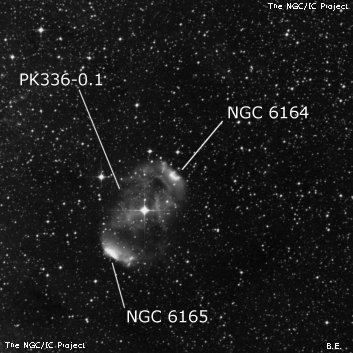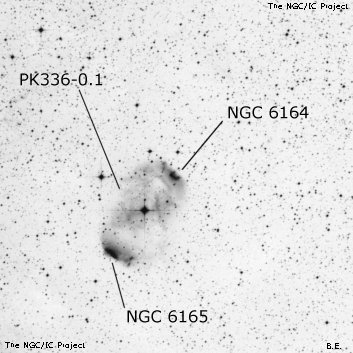NGC/IC Project Restoration Effort
(This is a very very beta version)
NGC6164


Basic Information
Location and Magnitude
Right Ascension: 16:33:41.0
Declination: -48:4:46
Constellation: NOR
Visual Magnitude:
Historic Information
Discoverer: Herschel J.
Year of discovery: 1834
Discovery aperture: 18.3
Observational
Summary description: eF (strongly susp), D * f nr
Sub-type: EN
Corwin's Notes
=====
NGC 6164 and NGC 6165 are the two brightest lobes of the bipolar nebula
associated with HD 148937, a hot, young, active star. These nebulae used to
be called "planetaries", but we now know them to be the result of energetic
winds from young, massive stars, rather than the dying gasps of dwarf stars
like the Sun. These two fairly bright patches of ionized gas neatly flank the
HD star. Deep exposures show more, though fainter, nebulosity closer to the
star.
JH picked these up in South Africa, and noted the star as a double. If it is,
it is a close double, not resolved on the short-exposure V plate scanned for
the DSS. JH's descriptions read "Neb violently suspected immediately
preceding a double star" (the definition of "violently" has undergone a bit of
a transformation since 1 July 1834!) and "F, S, lE, vglbM, 35[arcsec];
certain; follows a D *". Note, too, that JH puts plus-minus signs on the RA
and NPD for NGC 6164.
Steve's Notes
=====
NGC 6164
24" (4/11/08 - Magellan Observatory, Australia): this striking bi-polar nebula was quite impressive at 200x and UHC filter. The two bright loops or arcs are symmetrically placed along the rim, 2.6' NW and 3' SE of center with the southeastern arc brighter. The interior of the rim is filled with a fainter glow and the entire object forms a slightly elongated, 6.2'x5.2' oval. The nebula is dominated by the mag 6.8 central star (HD 148937). Mag 9 HD 148988 lies 3' NE of center.
18" (7/8/02 - Magellan Observatory, Australia): this bipolar emission nebula was a startling sight at 171x and UHC filter! A bright illuminating star (HD 148937 at V = 6.8) is surrounded by two lobes or loops to the NW (NGC 6164) and SE (NGC 6165). Both loops contain brighter arcs symmetrically placed at the opposite ends. This is a large object, ~6' diameter, with the southeastern knot a bit brighter. A mag 9 star is 3' NE, outside the nebulosity. Located near the midpoint of mag 4.5 Epsilon Normae 1.3¡ NW and NGC 6188/6193 a similar distance SE.



